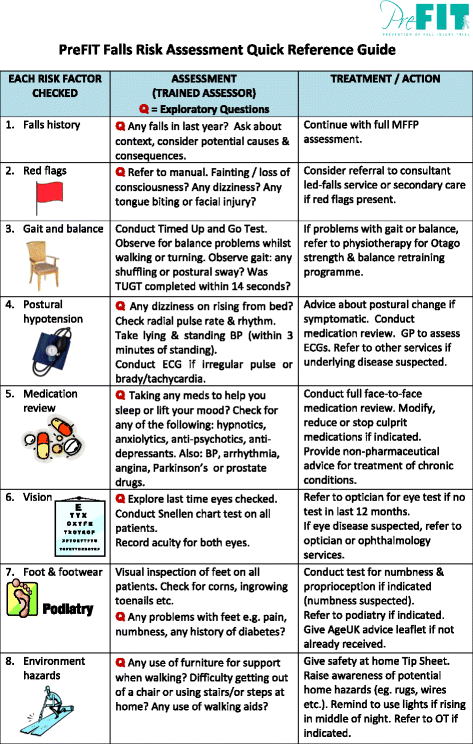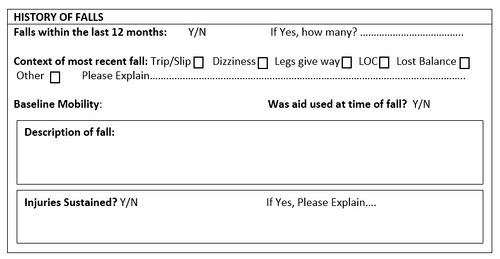The Dementia Fall Risk Ideas
Unknown Facts About Dementia Fall Risk
Table of ContentsSome Known Facts About Dementia Fall Risk.Get This Report about Dementia Fall RiskThe Ultimate Guide To Dementia Fall RiskThe Only Guide to Dementia Fall RiskEverything about Dementia Fall Risk
The FRAT has 3 areas: drop threat condition, threat variable list, and activity strategy. A Loss Threat Standing includes information about history of current drops, medications, mental and cognitive standing of the patient - Dementia Fall Risk.If the client scores on a risk aspect, the matching number of factors are counted to the person's fall risk score in the box to the far. If a client's autumn threat score amounts to 5 or greater, the individual is at high risk for falls. If the client ratings just four points or lower, they are still at some risk of falling, and the registered nurse ought to use their finest professional assessment to take care of all loss threat factors as part of an alternative treatment strategy.
These common approaches, in general, assist create a secure atmosphere that reduces unintended drops and delineates core preventative measures for all individuals. Signs are vital for patients at danger for falls.
The Single Strategy To Use For Dementia Fall Risk
Wristbands should include the patient's last and very first name, day of birth, and NHS number in the UK. Only red shade ought to be made use of to signify unique patient condition.
Things that are too much may require the patient to get to out or ambulate needlessly and can possibly be a danger or add to drops. Aids stop the patient from heading out of bed with no assistance. Nurses respond to fallers' telephone call lights quicker than they do to lights launched by non-fallers.
Aesthetic impairment can significantly trigger falls. Hip pads, when put on effectively, might minimize a hip fracture when loss takes place. Maintaining the beds closer to the flooring minimizes the danger of drops and significant injury. Placing the cushion on the floor substantially decreases fall threat in some medical care setups. Reduced beds are created to decrease the range a client falls after relocating out of bed.
An Unbiased View of Dementia Fall Risk
Clients who are tall and with weak leg muscular tissues that try to remain on the bed from a standing placement are likely to fall onto the bed since it's also reduced for them to lower themselves safely. If a high person efforts to get up from a webpage low bed without help, the person is likely to fall back down onto the bed or miss the bed and drop onto the flooring.
They're created to advertise prompt rescue, not to stop falls from bed. Audible alarms can likewise remind the person not to rise alone. Making use of alarms can also be an alternative to physical restraints. In addition to bed alarm systems, increased supervision for high-risk individuals likewise may assist avoid falls.

People with an evasion stride increase autumn opportunities considerably. To decrease loss danger, shoes ought to be with a little to no heel, thin soles with slip-resistant tread, and support the ankles. Advise patient to utilize nonskid socks to stop the feet from moving upon standing. Motivate patients to put on suitable, well-fitting shoesnot nonskid socks for ambulation.
The Definitive Guide for Dementia Fall Risk
In a research study, homes with sufficient illumination record fewer drops (Ramulu et al., 2021). Enhancement in lighting at home might reduce autumn rates in older adults.

Sitters are reliable for guaranteeing a protected, protected, and safe atmosphere. Research studies showed really low-certainty proof that caretakers reduce fall danger in intense treatment healthcare facilities and just moderate-certainty that alternatives like video surveillance can decrease sitter usage without enhancing autumn danger, suggesting that sitters are not as helpful as at first thought (Greely et al., 2020).
The Greatest Guide To Dementia Fall Risk

Increased physical conditioning lowers the risk for drops and limits injury that is sustained when fall transpires. Land and water-based workout programs may be similarly useful on balance and stride and thus minimize the danger for drops. Water exercise might add a favorable benefit on equilibrium and stride for women 65 years and older.
Chair Increase Exercise is a straightforward sit-to-stand exercise that aids enhance the muscles in the upper legs and buttocks and boosts movement and independence. The goal is to do Chair Surge exercises without making use of hands as the client becomes stronger. See sources section for Read Full Report an in-depth instruction on exactly how to execute Chair Rise workout.